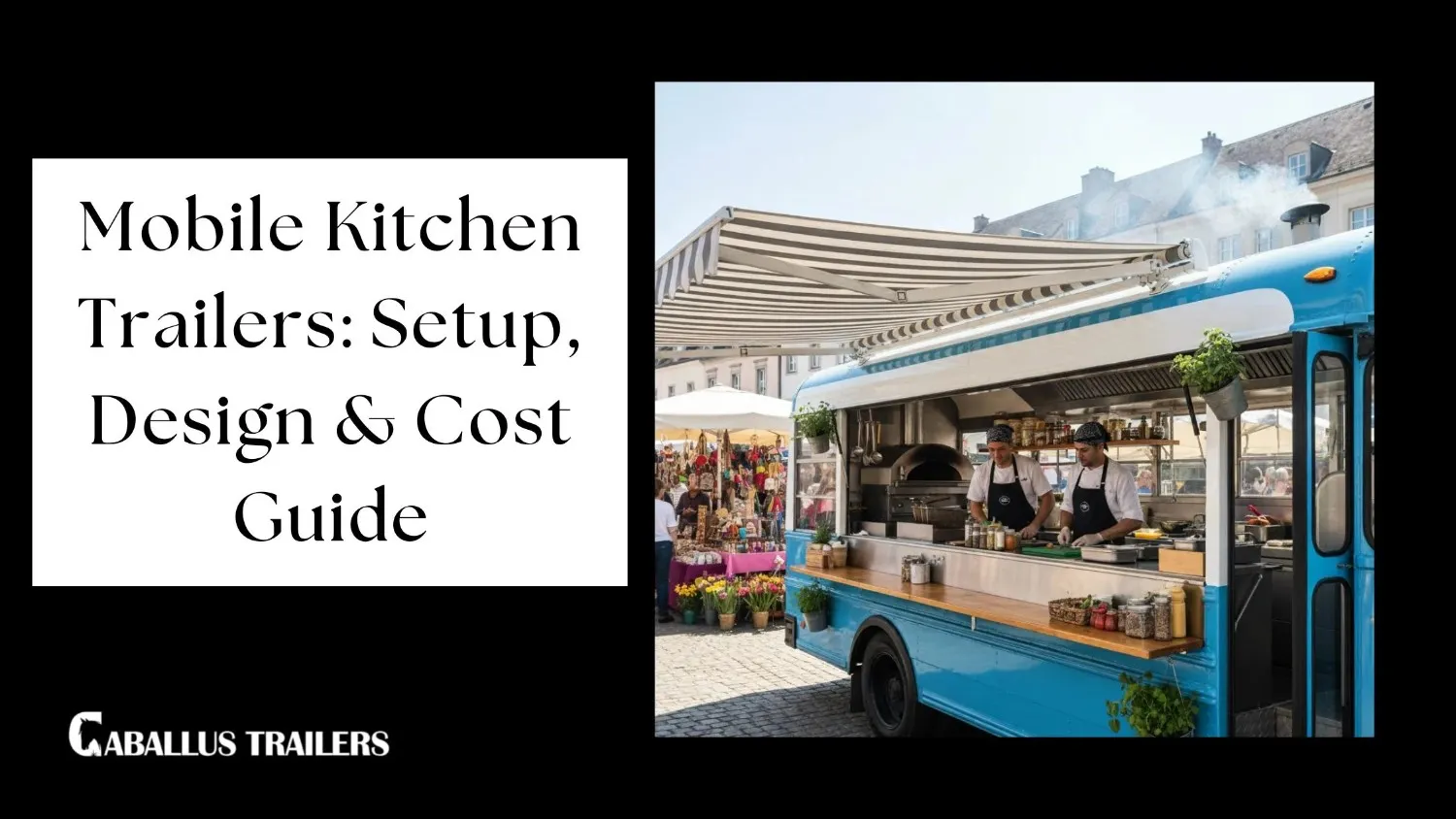If you’ve ever dreamed of running your own restaurant without the sky-high rent or long-term commitment, a mobile kitchen trailer might be the perfect solution. These versatile, fully equipped kitchens on wheels are revolutionizing the food industry; empowering chefs, entrepreneurs, and catering professionals to take their culinary creations directly to customers.
Whether you’re planning a gourmet food truck, a pop-up kitchen, or a full-scale mobile catering business, understanding how to set up, design, and budget for your mobile kitchen is essential.
In this detailed guide, we’ll cover everything you need to know; from layout and design considerations to legal requirements, cost breakdowns, and practical tips for maximizing efficiency.
What Is a Mobile Kitchen Trailer?
A mobile kitchen trailer is essentially a fully functional kitchen built inside a towable trailer. Unlike fixed food trucks (which are motorized), these units are designed to be hitched to a vehicle and transported to different locations.
They come equipped with all the essentials: cooking ranges, fryers, ovens, sinks, refrigerators, ventilation systems, and storage, making them ideal for:
- Food truck startups
- Event caterers and wedding vendors
- Disaster relief and emergency response kitchens
- Corporate event services
- Seasonal or festival food operations
The flexibility of a mobile kitchen trailer means you can take your business anywhere; a bustling downtown spot one day, a private event the next.
Benefits of Owning a Mobile Kitchen Trailer
Before diving into design and costs, it’s worth understanding why mobile kitchen trailers are booming.
1. Lower Startup Costs
Compared to brick-and-mortar restaurants, setting up a mobile kitchen costs a fraction of the investment. There’s no rent, property taxes, or extensive renovations.
2. Flexibility & Mobility
You can test different locations, events, and target audiences before committing to a permanent spot. Mobility lets you follow customer demand and maximize profits during peak seasons.
3. Faster Launch Time
A restaurant build-out can take months or years. In contrast, a mobile kitchen can be designed, built, and operational within weeks.
4. Scalability
Once your first unit succeeds, it’s easy to scale; adding more trailers to cover different cities or events.
5. Branding Opportunities
With custom wraps and creative designs, your trailer doubles as a moving billboard for your brand.
Mobile Kitchen Trailer Setup: Step-by-Step
Setting up a mobile kitchen trailer involves more than just buying a trailer and plugging in appliances. Here’s a structured plan:
Step 1: Define Your Food Concept
Your menu determines everything, from trailer size to equipment layout. For instance:
- A pizza trailer needs ovens, dough prep counters, and a vented hood.
- A burger trailer focuses on griddles, fryers, and refrigeration.
- A smoothie or coffee trailer may need minimal cooking but robust electrical capacity.
Clearly outline your menu and service model (e.g., walk-up window, catering events, drive-through setups).
Step 2: Choose the Right Trailer Size
Mobile kitchen trailers typically range from 12 to 28 feet in length.
- Small (12–16 ft): Ideal for simple menus or beverages.
- Medium (16–22 ft): Suitable for standard food truck-style operations.
- Large (24–28 ft): For full-service catering or multi-chef operations.
Consider towing capacity, storage needs, and event space restrictions before choosing your size.
Step 3: Plan the Layout
An efficient workflow is the backbone of a successful mobile kitchen. A good design ensures safety, comfort, and productivity.
Common Layout Tips
- Place cooking appliances on one side and prep/storage on the other for easy flow
- Install non-slip flooring and fire-rated materials.
- Keep refrigeration near prep zones to reduce movement.
- Provide adequate ventilation to prevent overheating.
- Include ample lighting and access to power outlets for flexibility.
Work with a certified food truck builder or designer who understands health codes and ergonomics.
Step 4: Power & Utility Setup
You’ll need three main systems:
a. Electrical
Runs lights, refrigeration, and small appliances. Most use a 50-amp 220V setup, often powered by:
- Onboard generators
- External power hookups
- Solar panels (optional for eco setups)
b. Plumbing
Health codes usually require:
- 3-compartment sink (for wash, rinse, sanitize)
- Handwashing sink
- Fresh and wastewater tanks
- Water heater
c. Gas & Ventilation
For gas appliances, install:
- Propane tanks with secure mounts
- Shut-off valves
- Commercial-grade exhaust hood with fire suppression system
Step 5: Permits & Inspections
Before you hit the road, check your local regulations. You’ll likely need:
- Mobile food facility permit
- Health department approval
- Fire and safety inspection
- Business license
- Parking and vending permits
Tip: Some regions have different codes for mobile kitchen trailers vs. food trucks, so always verify requirements locally.
Step 6: Branding & Interior Finishing
Your kitchen might be mobile, but your brand should feel premium. Consider:
- Custom vinyl wrap with logo and colors
- Digital menu boards
- Ambient LED lighting
- Durable countertops (stainless steel or food-grade polymer)
- Smart storage systems to save space
Step 7: Staff Training & Workflow
Even the best trailer won’t perform if the staff isn’t trained. Emphasize:
- Food safety and sanitation
- Equipment handling
- Emergency shutoff and maintenance procedures
- Order and serving efficiency
Mobile Kitchen Trailer Design: Layout Ideas & Inspiration
Design is about blending functionality with aesthetic appeal. Below are three proven layout styles:
a. Linear Layout
- Appliances line one wall.
- Ideal for narrow trailers and solo operators.
- Pros: Simple, low-cost, easy to maintain.
- Cons: Limited space for multiple staff.
b. Galley Layout
- Equipment on both sides with a central walkway.
- Most common and efficient for medium trailers.
- Pros: Balanced workflow, good storage.
- Cons: Can feel tight during rush hours.
c. Island or U-Shaped Layout
- Central workstation with wrap-around appliances.
- Great for large trailers or catering setups.
- Pros: Maximizes prep and serving efficiency.
- Cons: Higher build cost.
Pro Tip: Use 3D modeling tools or consult professional designers to visualize your setup before fabrication begins.
Cost Breakdown: How Much Does a Mobile Kitchen Trailer Cost?
The cost varies depending on size, equipment, and customization. Here’s a breakdown:
| Component | Estimated Cost (USD) |
| Trailer shell (new or used) | $8,000 – $20,000 |
| Kitchen equipment (grill, fryer, oven, etc.) | $10,000 – $30,000 |
| Plumbing, gas, and electrical setup | $5,000 – $10,000 |
| Ventilation and fire suppression | $3,000 – $8,000 |
| Interior finishing and flooring | $2,000 – $5,000 |
| Custom wrap and branding | $1,000 – $4,000 |
| Permits, licenses, inspections | $1,000 – $3,000 |
| Generator and utilities | $2,000 – $6,000 |
| Miscellaneous (storage, utensils, tech) | $1,000 – $2,000 |
Total Estimated Setup Cost: $25,000 – $70,000+
Used trailers can be found for less, but new custom-built units ensure better compliance and reliability.
Hidden Costs & Ongoing Expenses
Beyond setup, consider:
- Fuel & towing vehicle maintenance
- Insurance (liability + vehicle)
- Cleaning & repairs
- Marketing & event fees
- Staff wages (if applicable)
- Inventory & ingredient costs
A well-managed trailer can break even in 6–12 months, depending on your business model.
Legal, Health, and Safety Compliance
Compliance is not optional; failing an inspection can shut you down instantly.
Key Compliance Areas
- Health Codes: Meet food storage, prep, and sanitation standards.
- Fire Safety: Install extinguishers, hood suppression, and propane cutoffs.
- Electrical Safety: Use grounded outlets and waterproof fittings.
- Waste Disposal: Follow rules for greywater and grease management.
Always consult your local health department before construction — retrofitting mistakes can be expensive.
Maximizing Efficiency in Your Mobile Kitchen
A successful mobile kitchen trailers is all about smart workflow.
Efficiency Tips
- Use modular equipment to reconfigure easily.
- Keep high-traffic zones (grill, sink, fridge) within arm’s reach.
- Install overhead shelves for dry goods.
- Use compact multi-function appliances (e.g., combi ovens).
- Opt for energy-efficient generators and LED lighting.
Tech Add-ons
Modern mobile kitchens integrate technology for smoother operations:
- POS systems for quick order processing.
- Digital thermometers and sensors for food safety.
- Wi-Fi hotspots for mobile payments and marketing.
Popular Mobile Kitchen Trailer Ideas in 2025
Mobile kitchens aren’t one-size-fits-all. Here are trending niches:
| Type | Description |
| Gourmet Food Trailer | Premium menu, chef-curated dishes for events. |
| BBQ or Grill Trailer | Equipped with smokers and outdoor serving windows. |
| Coffee & Beverage Trailer | Espresso machines, blenders, compact fridges. |
| Bakery Trailer | Ovens, display shelves, and prep tables. |
| Catering Trailer | Full-scale kitchens for private or corporate events. |
| Eco-Friendly Trailer | Solar panels, composting waste systems, and sustainable design. |
| Event Kitchen Trailer | Used for festivals, weddings, or film shoots. |
How to Finance Your Mobile Kitchen Trailer?
If buying outright isn’t feasible, explore:
- Equipment financing or leasing
- Small business loans or microloans
- Crowdfunding campaigns
- Partnerships or investors
- Government grants for small food businesses
Be sure to prepare a solid business plan and financial projection to secure funding.
Maintenance Tips for Longevity
A well-maintained trailer can last over a decade.
- Deep-clean weekly (especially vents and fryers).
- Check propane and gas lines for leaks.
- Test electrical systems monthly.
- Lubricate door hinges and service the generator regularly.
- Store indoors or cover the trailer during the off-season.
Regular upkeep not only extends lifespan but also ensures compliance and safety.
The Future of Mobile Kitchens
The mobile kitchen industry is projected to grow rapidly through 2025 and beyond, fueled by:
- Increasing event-based dining demand
- Remote catering for outdoor and hybrid experiences
- Rising food entrepreneurship among young chefs
- Sustainable and low-waste food concepts
With innovations like solar-powered setups, smart inventory systems, and AI-based menu analytics, mobile kitchens are becoming more efficient and eco-friendly than ever.
Key Takeaways
| Aspect | Summary |
| Startup Cost | $25,000 – $70,000+ depending on customization |
| Ideal Size | 16–24 ft for standard operations |
| Core Equipment | Cooking range, fridge, sink, generator, hood |
| Permits Needed | Health, fire, vending, and business licenses |
| ROI Period | 6–12 months with efficient operation |
| Best Use Cases | Food service startups, caterers, and event vendors |
Final Thoughts
A mobile kitchen trailer is more than a food truck; it’s a portable business opportunity with immense potential. Whether you’re a chef ready to go solo, a catering company expanding reach, or a brand exploring experiential marketing, a well-planned trailer offers flexibility, affordability, and creative freedom.
By investing in thoughtful design, reliable equipment, and strategic branding, you can transform a simple trailer into a profitable, crowd-favorite culinary hub on wheels.
The road to success starts with one step; or in this case, one wheel turn. Contact Caballus Trailers to book your Mobile Kitchen Trailers!









Leave a Reply